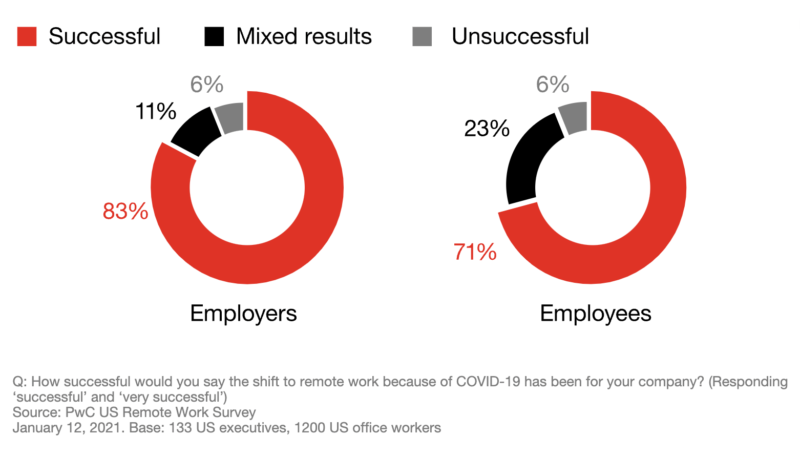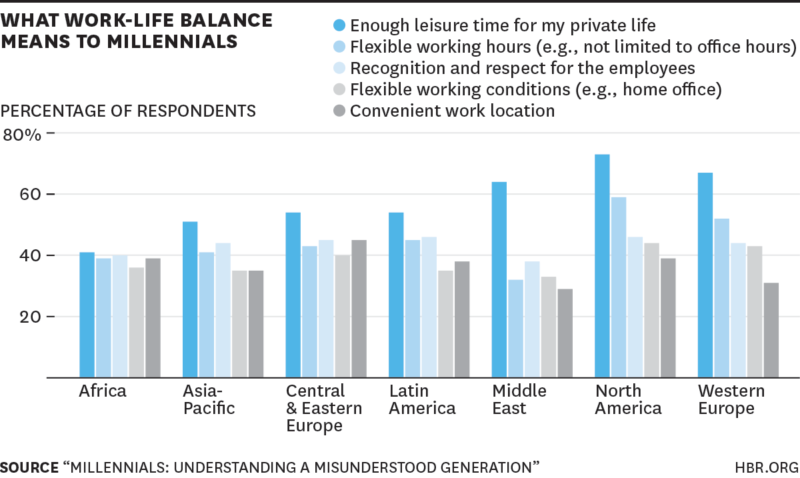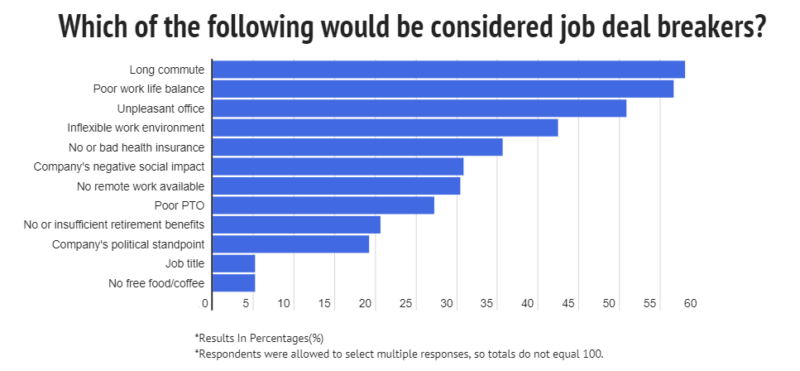
It’s no secret that today’s workers and job seekers care more than ever about employee work-life balance. But for employers, it can be difficult to know how to support work-life balance in a meaningful and effective way.
Work-life balance — it might as well be the battle cry of the workforce these past two years of the pandemic. For starters, the massive remote work experiment caused by COVID-19 finally gave millions of workers something they’ve wanted for years: flexibility.
And despite the challenges posed by lockdowns and social distancing guidelines, 90% of workers said they had a positive experience working remotely, according to Buffer’s 2022 State Of Remote Work report.
Source: Buffer
More importantly, however, the majority of employers now know that remote work can work. PwC’s US Remote Work Survey found that 83% of employers believe their shift to remote work at the height of the pandemic was successful.
Source: PwC
But offering your workers the flexibility to choose when and where to work is just one of many ways to improve employee work-life balance. In fact, depending on your team’s needs, they may not even want to work remotely full-time, opting instead for a combination of in-office and remote work (more on this later).
Related Reading: The Benefits of Flexible Working
What is work-life balance?
The definition of work-life balance varies from person to person, but generally speaking, it means creating a lifestyle that allows you to enjoy your professional and personal lives equally.
For organisations, supporting employee work-life balance often means creating initiatives and providing resources to help teams find a clear division between work and other commitments, such as family, leisure pursuits or personal development. This looks simple enough on paper, but initiatives can easily miss the mark, especially if they don’t address the causes of poor work-life balance in the first place.
When work-life balance misses the mark
Let’s look at what millennials think of work-life balance. According to a 2015 study by INSEAD’s Emerging Markets Institute, Universum, and the HEAD Foundation, global millennials considered flexible hours and working conditions among the top drivers of work-life balance.
Source: Harvard Business Review
Anyone looking at this data would conclude that flexible working is integral to work-life balance. However, there’s a lot more nuance to this discussion.
While the global shift to working from home provided workers with much-needed flexibility, it also introduced negative experiences. Research by Robert Half shows that remote workers in 2020 ended up working longer, with 70% working on weekends and 45% regularly working more hours.
In other words, employers need to think of improving employee-work life as an exercise of creating meaningful and lasting change. In the case of flexible working, it’s not enough for employers to offer remote working and call it a day. There needs to be follow-up training on managing boundaries, burnout prevention and stress management.
Related Reading: How to Improve Remote Working: Lessons From Lockdown
The dangers of poor employee work-life balance
For better or worse, experts agree that the traditional eight-hour workday and 40-hour workweek is no longer a tenable model in the modern workplace. In fact, with 52% of US adults working over 40 hours every week, you could argue that the 40-hour work week is already out of fashion.
But long hours are just one driving factor of poor employee work-life balance. Issues like bullying, increased responsibilities at work, pay not keeping up with increased expenses, and no access to career development opportunities can all contribute to inadequate work-life balance. Whatever the case, the outcomes hurt both workers and employers.
1. Burnout
In 2019, the World Health Organization (WHO) updated the definition of “burnout” in the International Classification of Diseases (ICD-11) — the global handbook of health conditions and causes of death.
The WHO describes burnout as “a syndrome conceptualised as resulting from chronic workplace stress that has not been successfully managed.” According to Ceridian’s 2022 Pulse of Talent report, 79% of surveyed UK workers have experienced burnout — 35% report high or extreme levels.
Related Reading: How to Build an Employee Engagement Strategy for 2022
2. Poor employee engagement
Employee wellbeing is the often overlooked bridge connecting work-life balance and employee engagement. When workers can’t set healthy boundaries between their work and personal lives, their health and sense of wellbeing suffer, leading to dissatisfaction and boredom at work. This can lead to absenteeism and lost work days — one study of workers in Nordic countries found a direct link between poor work-life balance and elevated odds of self-reported sickness absence.
When employees are engaged, they’re more likely to be invested in their work. In fact, organisations with an engaged workforce have double the rate of success compared to less engaged companies.
Related Reading: How to Build Employee Engagement, Satisfaction and Increase Staff Retention
3. Stress and increased risk of health problems
Poor employee work-life balance and stress feed off each other and put your people at a higher risk of health conditions such as, but not limited to:
- Insomnia
- Stroke
- Coronary heart disease.
Insufficient work-life balance also increases the risk of mental health problems, such as anxiety and depression. A five-year study on long working hours found that the risk of depression was 1.66 times higher in healthy individuals who worked over 55 hours a week.
4. Difficulties attracting and retaining top talent
Source: Zippia
Contrary to popular belief, it’s not just young workers (millennials and Gen Z) who prioritise work-life balance. Every generational cohort wants better work-life balance, and it influences their decision to both join and stay with a company. According to recruitment services company Zippia, 57% of employees consider poor work-life balance a deal-breaker when considering a job.
Employee work-life balance: A look at the numbers
- Workaholism is a problem in Britain. Four in 10 adults admit they can’t leave work alone, and one in six routinely spend over 11 hours a week working away from the office. (The Independent)
- Only 21% of workers feel engaged at work — 79% of employees are either not engaged or actively disengaged in the workplace. Meanwhile, only 33% of employees feel they are thriving at work. (Gallup’s State of the Global Workplace: 2022)
- Nearly half (46%) of HR leaders in 2017 said that burnout was responsible for up to half of their annual workforce turnover. (Ultimate Kronos Group)
- 70% of women and 65% of men in the UK consider work-life balance more important than pay and employee benefits combined. (Ciphr)
- Bad bosses are terrible for work-life balance. 60% of employees believe bad bosses have the biggest negative impact on their wellbeing at work. (Workfront)
- Researchers estimate that $125 to $190 billion is spent annually to address the physical and mental effects of burnout and workplace stress — equivalent to around 5% to 8% of national healthcare spending. (Harvard Business School)
Strategies to increase employee work-life balance
So, what can employers do to support work-life balance for their employees? Here are some ideas to get you started.
1. Workplace therapy or counselling
Workplace therapy or counselling is a way to help your employees deal with a range of issues, including stress, anxiety, depression, relationship difficulties and substance abuse. A therapist can work with the employee to identify the cause of their problem, understand how it affects their work and develop a plan to address it.
Therapy or counselling is typically provided through third-party services like Employee Assistance Programmes (EAPs), which were critical in supporting employee health and wellbeing at the height of the pandemic. EAP initiatives saw nearly 350,000 more users in 2021 compared to the previous year and generated an ROI of £8.00 for every £1.00 spent.
2. Company get-togethers
While the trajectory of work is headed towards more remote work, the office (or some form of co-located workplace) will still play a vital role in facilitating the social aspect of company culture and collaboration.
This is particularly true for company get-togethers. Spending facetime with colleagues and mentors can help your workers feel they’re part of a team and develop a positive attitude about their work. Face-to-face social activities can help prevent loneliness and communication silos, allowing teams to work more effectively.
3. Electric car scheme
Bills and personal expenses are major risk factors for work-life balance. And with a cost of living crisis gripping the UK, workers will need all the support they can get to make ends meet.
For employers, one way to ease the burden on workers is through initiatives like an electric car scheme — an initiative modelled after the cycle to work scheme, but for electric vehicles (EVs). The programme allows employers to lease an EV for their employees, who then pay for it via a salary sacrifice arrangement. For workers, an EV enables them to reduce spending on fuel, ULEZ charges and congestion charges — great for those who need to drive to work.
4. Team volunteering
Providing workers with opportunities to volunteer through your organisation can dramatically improve your teams’ sense of fulfilment and wellbeing. A UnitedHealthcare study found that 75% of adults who volunteer say they are physically healthier, and 79% said volunteering reduced their stress levels.
However, the last thing you want to do is tack on volunteering to your workers’ existing hours. Make it a policy to provide each employee with paid time off to volunteer to incentivise community participation.
5. Private medical insurance
Offering private health insurance to your workers delivers significant benefits for your organisation and teams. For employees, private medical insurance comes with:
- Shorter waiting times for treatment
- Round-the-clock access to a GP or nurse practitioner hotline
- Coverage of family members/dependents
- Faster access to specialist care providers.
Providing private healthcare insurance also shows you want to go the extra mile for your people and care deeply about their health and wellbeing.
6. Gym discounts
Government guidance notes that being inactive is “as dangerous to our health as smoking,” adding that sitting down for prolonged periods contributes to the leading causes of workplace absence: stress, anxiety and back injuries.
Like private health insurance, subsidised corporate gym memberships help protect your teams’ health and wellbeing, encouraging them to live more active lifestyles. And with the myriad of gyms and fitness centres offering corporate fitness schemes, it’s never been easier or more affordable for employers to add gym memberships to their list of worker benefits.
7. Hybrid working
Our research on employee attitudes in 2021 revealed that a combined 64% of workers in the UK and US want a permanent mix of remote work, in-office work and working in an approved public space — a working arrangement known as hybrid working.
Related Reading: The Hybrid Working Model: What Is It and Can It Work?
If you haven’t already, consider making hybrid working a permanent policy for your workers. Now is the perfect time to outline your practices in a hybrid working policy, covering information such as:
- Remote and in-office work procedures
- Legal implications of hybrid working
- Communication practices
- Technology and equipment protocols
- Employee wellbeing policies
- Performance management
- Inclusion and equality
- Employee lifecycle.
Putting your protocols and guidelines down on paper ensures you’re setting expectations with your teams and have contingency plans in place when issues arise.
Employee work-life balance is not a one-size-fits-all process
Work-life balance is a very personal concept, so much so that these tips, while great, might not be for everyone. Take the time to talk to your people and learn their motivations, pain points and challenges. We all have unique quirks, so find creative solutions to match your situation.
Remember, by supporting your employees’ work-life balance, you can get the best of both worlds. You’re protecting your workers’ health and wellbeing and building an engaged, productive workforce.
Be sure to follow the Cloudbooking blog to get more insights on how to support employee work-life balance in your organisation. If you need a solution to help you create an efficient flexible or hybrid working environment with smart office capabilities, get in touch with the Cloudbooking team. Schedule an obligation-free demo to learn how our workspace management platform works.






